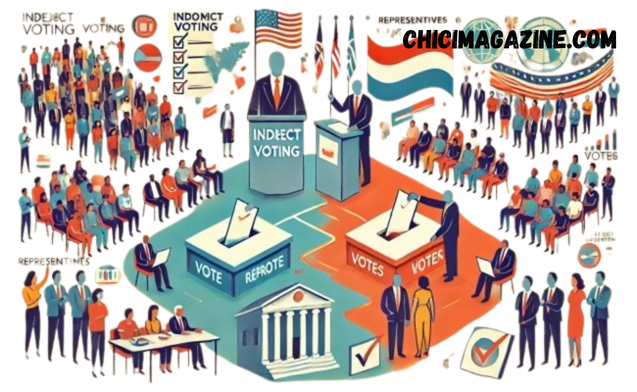Have you ever heard of oblique balloting? If you’re scratching your head, you’re no longer alone. Many people are blind to this charming machine that shapes political landscapes around the world. While direct balloting is what most oldsters realize—casting a ballot for a candidate they aid—indirect voting for dummies balloting takes a one-of-a-kind route.
Imagine electing someone without at once selecting them yourself! This might not sound very easy, but it’s more unusual than what you believe you studied. Indirect vote casting can affect everything from local governments to national elections, and knowledge of its mechanics can empower you as an informed citizen.
In this manual designed for people who need to demystify this concept, we’ll explain the essentials of oblique voting in simple terms. Whether you are curious about how it works or just want to electrify buddies at your next amassing with a few minutes, we have got you covered! Let’s unravel the intriguing world of oblique balloting for dummies and collectively unravel its complexities.
Table of Contents
Understanding the Basics of Indirect Voting
Indirect voting is a machine in which voters don’t pick their representatives at once. Instead, they opt for delegates or intermediaries who then make the very last selection on behalf of the electorate. This approach can appear a bit puzzling in the beginning.
In many instances, indirect balloting happens in large organizations or governmental bodies. Think of it as a tiered technique for selection-making. Voters agree with those elected delegates to represent their perspectives and hobbies when it comes time to vote for essential places of work.
This model can help streamline elections by reducing the number of applicants that need to be considered in advance. It also allows those with knowledge or information about specific problems to weigh in on important decisions.
Understanding this machine is critical as it impacts how legal guidelines are made and policies are shaped, regularly impacting everyday lives without maximum citizens’ direct involvement.
Pros and Cons of Indirect Voting
Indirect balloting has its own set of blessings and downsides. One notable advantage is that it streamlines the election system. By electing representatives to make choices on behalf of larger groups, it can reduce the number of individuals needed for each decision.
Another benefit is that it allows for more informed decisions. Representatives frequently have better access to data and knowledge than the general electorate, leading to potentially wiser selections.
However, indirect vote casting has drawbacks. It can create a disconnect between elected officers and their constituents. Voters may feel their voices are diluted because they depend on someone else’s judgment.
Additionally, there’s a risk of misrepresentation. If representatives act against their ingredients’ interests or fail to speak correctly, voter dissatisfaction may grow notably.
These contrasting components spotlight the complexities surrounding oblique balloting structures in diverse governance systems.
Different Forms of Indirect Voting
indirect voting for dummies is available in numerous forms, each with its particular representation technique. One common approach is the Electoral College, used in the United States presidential elections. Here, citizens elect electors who then cast votes for candidates.
Another kind entails parliamentary systems wherein citizens vote for celebration representatives instead of personal applicants. These representatives are chosen through parties to shape a government primarily based on their collective assistance.
In some nations, like India, nearby councils or assemblies may be elected, but not directly. Members of these bodies then choose higher officials or leaders.
There’s also the concept of proxy balloting, in which people authorize someone else to forge a poll. This is frequently visible in corporate settings or among expatriates.
Understanding those different paperwork helps clarify how oblique balloting can shape political landscapes throughout international locations. Each system reflects cultural values and governance structures uniquely tailored to its societies.
Examples of Countries That Use Indirect Voting Systems
Several international locations around the world make use of oblique voting structures to decide on their leaders. One top-notch example is India, where the President is selected using an electoral university composed of elected individuals from Parliament and national legislative assemblies.
In Germany, citizens don’t immediately select their Chancellor. Instead, they cast votes for events in a federal election. The party with the bulk then selects its chief to become Chancellor.
Another exciting case is America. Here, citizens vote for electors who pledge to vote for a presidential candidate for the duration of the Electoral College method.
Even in Italy, legislators are not directly elected via regional representatives who select the President of the Republic among themselves. Each system reflects specific political systems and cultural contexts that form how democracy operates inside one’s international location.
How to Cast an Indirect Vote
Casting an indirect vote entails some beautiful steps. First, you usually pick out representatives to make choices on your behalf. This means locating honest applicants that are aligned with your values.
Next, familiarize yourself with the balloting process for your area. Some systems may additionally require registration or adherence to specific timelines. Make sure to test nearby recommendations, as they could vary extensively.
On election day, head to the polling station where your chosen delegates are listed. You’ll want to verify their names and fill out a ballot that reflects whom you’re supporting circuitously.
After casting your vote for those representatives, it is important to stay knowledgeable about their actions and rules throughout their tenure. Engaging in discussions and community forums keeps the democratic system alive even after you’ve cast your poll!
Challenges and Controversies Surrounding Indirect Voting
Indirect balloting can sometimes have challenges. One fundamental area for improvement is the capability for disengagement. When citizens feel disconnected from their representatives, they’ll get bored with the electoral method.
Another challenge involves transparency. Voters often have restricted data about how their elected officers will act on their behalf. This lack of clarity can breed distrust and skepticism in the direction of the complete gadget.
Furthermore, oblique voting can be manipulated by political elites. High-rating birthday celebration contributors may exert undue influence over delegate choices, sidelining grassroots voices.
The complexity of these systems can also confuse the electorate. Understanding how delegates are chosen and votes are counted requires an effort many may not invest in.
Accusations of injustice frequently arise while results do now not reflect public sentiment appropriately due to disparities in representation or vote distribution techniques used inside these structures.
Conclusion
indirect voting for dummies can seem complicated at first glance, but breaking it down reveals its central concepts and features. Understanding this system is important for anyone looking to navigate democratic approaches efficaciously.
The executives of oblique vote casting encompass the capability for more informed picks made by elected representatives. However, it also comes with drawbacks like reduced voter engagement and a capability disconnect between parties and their representatives.
Various varieties of indirect voting exist internationally, showcasing practices tailor-made to specific political landscapes. Countries such as India and the USA employ those structures in unique methods, demonstrating how tradition influences electoral mechanisms.
Casting an oblique vote involves knowing who you’re electing to represent your hobbies—this could be through neighborhood councils or within large assemblies. The system varies from region to region, so it is vital to familiarize yourself with nearby guidelines.
Despite its deserves, oblique vote casting faces demanding situations that spark debate among students and residents alike. Concerns about illustration accuracy and transparency frequently arise when discussing this model’s effectiveness in reflecting public sentiment.
Navigating the arena of oblique balloting should not be daunting. With clean facts and expertise, you could contribute meaningfully to your democracy.



